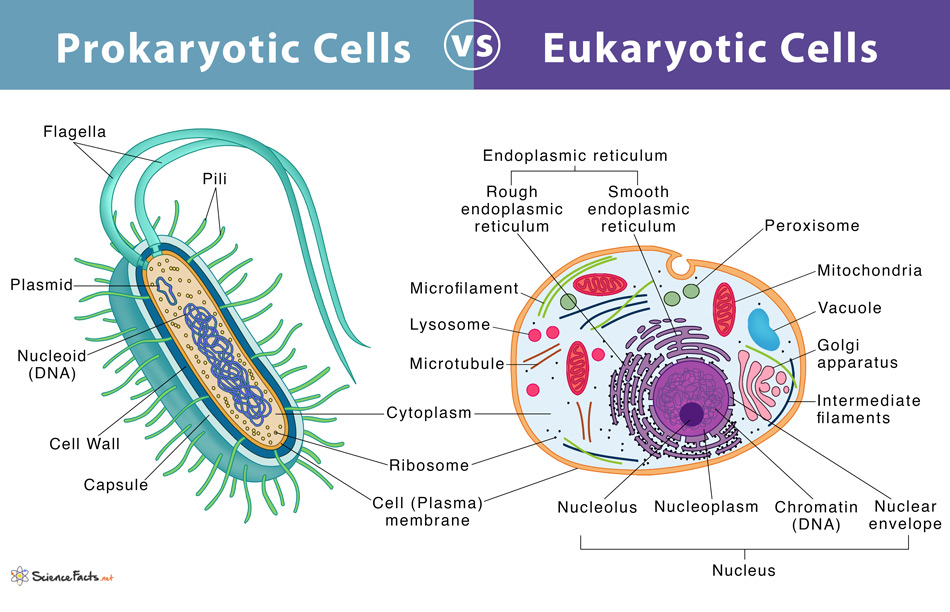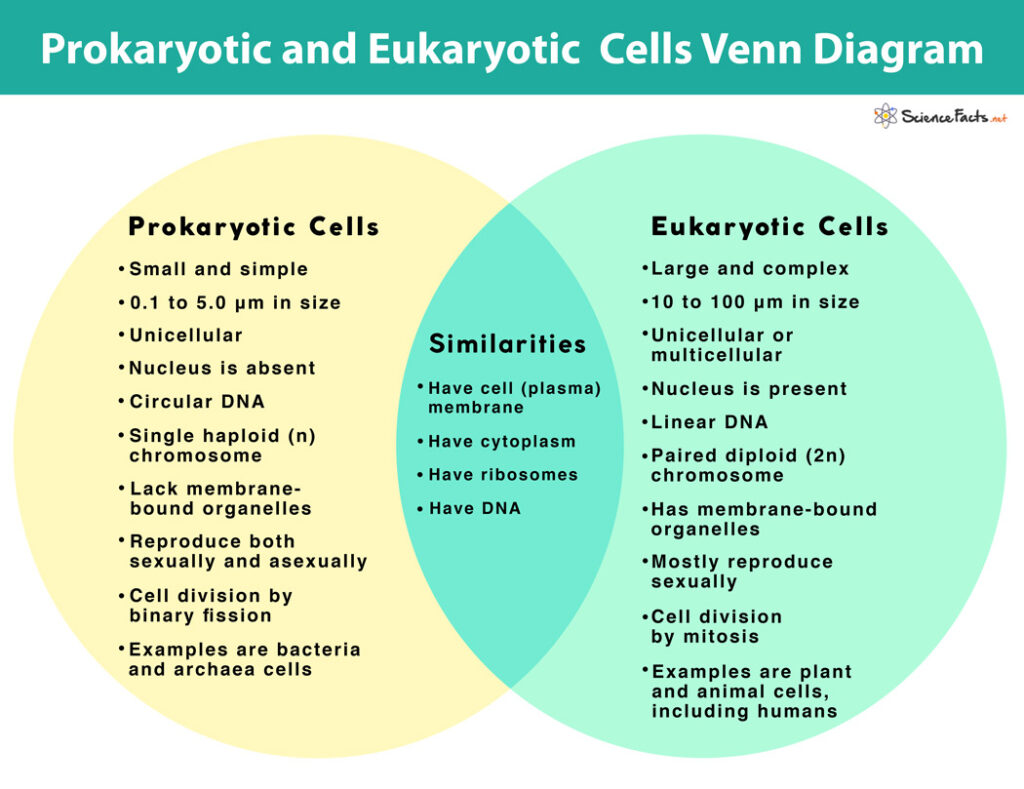Prokaryotes vs. Eukaryotes
All living organisms can be grouped into two types based on their fundamental cell structure. They are prokaryotes and eukaryotes, and the cells they possess are called prokaryotic cells and eukaryotic cells.
Prokaryotes are primitive organisms lacking a nucleus and membrane-bound organelles. The term ‘prokaryote’ is derived from the Greek words ‘pro’, meaning ‘before’ and ‘karyon’, meaning ‘kernel’. Together it means ‘before nuclei’. In contrast, eukaryotes are advanced organisms with a well-defined nucleus and membrane-bound organelles. The term ‘eukaryotes’ is derived from the Greek words ‘eu’, meaning ‘good’ and ‘karyon’, meaning ‘kernel’, meaning ‘true nuclei’. The eukaryotes are thought to have originated from the prokaryotes about 2.7 billion years ago.
Compare and Contrast Prokaryotic and Eukaryotic Cells
Although they share some common characteristics, prokaryotic and eukaryotic cells differ in most aspects, such as cell size, shape, organization, and life cycle, including reproduction. The main differences are given below.
What is the Difference between Prokaryotic and Eukaryotic Cells
| Basis | Prokaryotic Cell | Eukaryotic Cell |
|---|---|---|
| 1. Examples | Cells of bacteria, archaea or archaebacteria, and cyanobacteria or blue-green algae | Cells of plants, animals, fungi, algae, and protozoa (protists) |
| 2. Type | Unicellular | Unicellular or multicellular |
| 3. Size (in diameter) | 0.1 to 5.0 μm | 10 to 100 µm |
| 4. Type of Organization | Simple | Complex |
| 5. Cell Wall | Usually present. Made of peptidoglycan or mucopeptide | Usually absent. If present (in plants and fungi) made of cellulose |
| 6. Nucleus | Absent. Instead, have a nucleoid that is devoid of the membrane | Present and membrane-bound |
| 7. DNA | Circular, double-strandedFound freely in the cytoplasm. Naked (not bound to proteins). Little repetitive DNA and no introns | Linear, double-stranded. Found within the nucleus. Bound to histone proteins. A large amount of repetitive DNA and introns |
| 8. Chromosome Number | Single haploid (n) chromosome | Paired diploid (2n) chromosome |
| 9. Plasmid | Present. | Absent. |
| 10. Ribosome type | 70S type, with 50S and 30S subunits. Smaller in size compared to the eukaryotic cell | 80S type, with 60S and 40S subunits. Larger in size compared to the prokaryotic cell |
| 11. Mitochondria | Absent | Present |
| 12. Chloroplast | Absent. Chlorophyll scattered in the cytoplasm | Present in plants and algae |
| 13. Endoplasmic Reticulum | Absent | Present |
| 14. Golgi Apparatus | Absent | Present |
| 15. Lysosomes | Absent | Present |
| 16. Peroxisomes | Absent | Present |
| 17. Mesosome | Present | Absent |
| 18. Centrosome | Absent | Present except for flowering plants |
| 19. Cytoskeleton | Absent | Present |
| 20. Flagella | Microscopic in size. Simple in structure, made of protein, flagellin | Submicroscopic in size. Complex in structure, with 9+2 arrangement of microtubules |
| 21. Cilia | Absent | Present |
| 22. Mode of Reproduction | Asexual | Mostly sexual |
| 23. Cell Division | Asexually by binary fission but can exchange genetic information by conjugation, transformation, and transduction | Through mitosis |
| 24. Generation Time | Shorter (20 to 60 minutes) than eukaryotes | Longer (12 to 24 hours) than prokaryotes |
| 25. Metabolic Rate | Higher than eukaryotes | Lower than prokaryotes |
| 26. Respiration | Via cytoplasm membrane | Via mitochondria |
| 27. Electron Transport Chain | Found in the cell membrane | Found in the mitochondrial membrane |
| 28. DNA Replication | Occurs in the cytoplasm Has one origin of replication | Occurs in the nucleus. Has multiple origins of replication |
| 29. Transcription and Translation (Protein Synthesis) | Occurs simultaneously. Both occur in the cytoplasm | Occurs one after the other. Transcription occurs in the nucleus, and translation in the cytoplasm |
| 30. Gene Expression (Regulation) | Expressed in groups called operons | Expressed individually |
| 31. Cytoplasmic Streaming | Absent | Present |
| 32. Glycocalyx | Present in capsule or slime layer | Present in cells lacking a cell wall |
What do Prokaryotes and Eukaryotes have in Common
Both prokaryotic and eukaryotic cells are alike in some ways and share some common features that are given below:
- Plasma Membrane, an outer covering that allows selective entry and exit of substances in and out of the cell, is found in both cell types. Their fundamental composition in forming a lipid bilayer with embedded proteins is also the same.
- Both contain cytoplasm, a jelly-like fluid that fills the cell’s entire interior, where all other cellular components are found.
- DNA is the genetic material in both cell types.
- In both, ribosomes help in protein synthesis.
FAQs
Ans. Viruses are not cells and thus are neither a prokaryote nor a eukaryote.
Ans. Amoeba, being a protist, are eukaryotes.
Ans. Yeast, being fungi, is a eukaryote.
Ans. Eubacteria, or ‘true’ bacteria, are a class of bacteria and thus are prokaryotes.
Ans. E. coli,being bacteria, is a prokaryote.
Ans. Human cells have a true nucleus and membrane-bound organelles and thus are eukaryotes.
Ans. Euglena, being protist, are eukaryotes.
Ans. Cyanobacteria or blue-green algae lack membrane-bound organelles and well-organized nuclei and thus are prokaryotes.
Ans. Yes. Eukaryotes originated at least 2.7 billion years ago, following almost 1 to 1.5 billion years of prokaryotic evolution.
Ans. Prokaryotic protein synthesis uses 70S ribosomes in comparison to 80S ribosomes in eukaryotes. Protein synthesis in prokaryotes is a continuous process with transcription. On the other hand, in eukaryotes, protein synthesis starts after transcription is complete.
Ans. Elodea is a plant genus, and thus is a eukaryote.
Ans. Onion cells and cheek cells are eukaryotic cells because they possess membrane-bound organelles and a well-organized nucleus.
Ans. Mold, being fungi, is a eukaryote.
Ans. HIV, being a virus, is neither a prokaryote nor a eukaryote.
Ans. Streptococcus is a bacterial genus and thus is a prokaryote.
Ans. As cancer cells are found only in multicellular organisms, which are eukaryotes, they are eukaryotic cells.
Ans. All red blood cells, including rodent red blood cells, are eukaryotic because they have a true nucleus and membrane-bound organelles.
Ans. Fish cells, including sharks, are eukaryotic because they have a true nucleus and membrane-bound organelles.
Ans. Monera is a kingdom that includes bacteria and archaea. They have a prokaryotic cell organization.
Ans. Saccharomyces is a genus of fungi, including many yeast species. They are thus eukaryotes.
Ans. Spirillum is a bacterial genus and thus is a prokaryote.
Ans. Vibrio cholera, being bacteria, is a prokaryote.
-
References
Article was last reviewed on Monday, October 9, 2023





